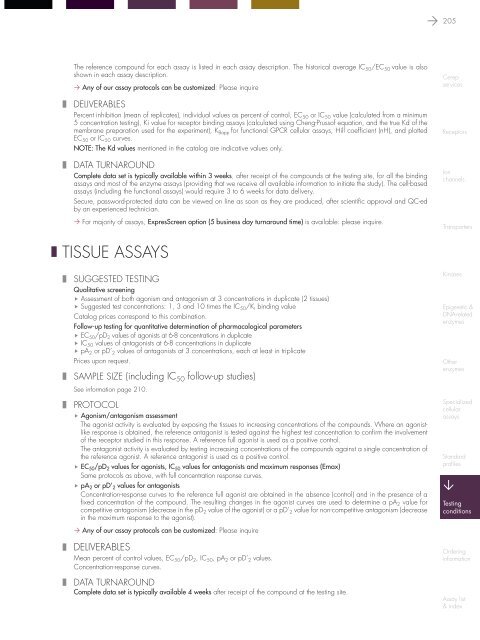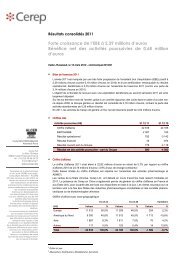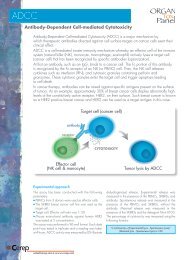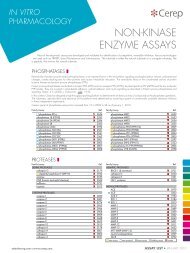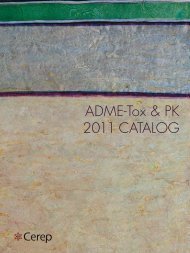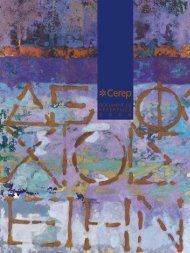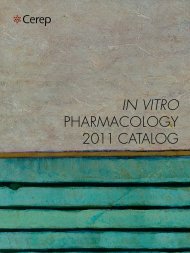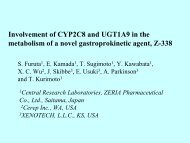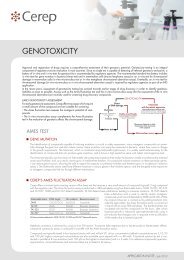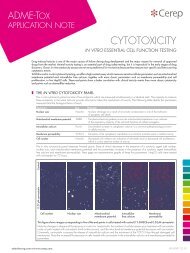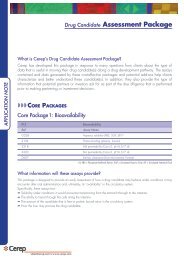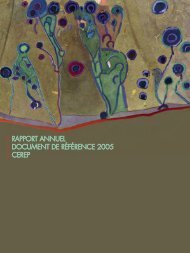in vitro PHARMACOLOGY 2011 CATALOG - Cerep
in vitro PHARMACOLOGY 2011 CATALOG - Cerep
in vitro PHARMACOLOGY 2011 CATALOG - Cerep
You also want an ePaper? Increase the reach of your titles
YUMPU automatically turns print PDFs into web optimized ePapers that Google loves.
205<br />
The reference compound for each assay is listed <strong>in</strong> each assay description. The historical average IC 50 /EC 50 value is also<br />
shown <strong>in</strong> each assay description.<br />
Any of our assay protocols can be customized: Please <strong>in</strong>quire<br />
❚ deliverables<br />
Percent <strong>in</strong>hibition (mean of replicates), <strong>in</strong>dividual values as percent of control, EC 50 or IC 50 value (calculated from a m<strong>in</strong>imum<br />
5 concentration test<strong>in</strong>g), Ki value for receptor b<strong>in</strong>d<strong>in</strong>g assays (calculated us<strong>in</strong>g Cheng-Prussof equation, and the true Kd of the<br />
membrane preparation used for the experiment), K Bapp for functional GPCR cellular assays, Hill coefficient (nH), and plotted<br />
EC 50 or IC 50 curves.<br />
NOTE: The Kd values mentioned <strong>in</strong> the catalog are <strong>in</strong>dicative values only.<br />
❚ data turnaround<br />
Complete data set is typically available with<strong>in</strong> 3 weeks, after receipt of the compounds at the test<strong>in</strong>g site, for all the b<strong>in</strong>d<strong>in</strong>g<br />
assays and most of the enzyme assays (provid<strong>in</strong>g that we receive all available <strong>in</strong>formation to <strong>in</strong>itiate the study). The cell-based<br />
assays (<strong>in</strong>clud<strong>in</strong>g the functional assays) would require 3 to 6 weeks for data delivery.<br />
Secure, password-protected data can be viewed on l<strong>in</strong>e as soon as they are produced, after scientific approval and QC-ed<br />
by an experienced technician.<br />
For majority of assays, ExpresScreen option (5 bus<strong>in</strong>ess day turnaround time) is available: please <strong>in</strong>quire.<br />
<strong>Cerep</strong><br />
services<br />
Receptors<br />
Ion<br />
channels<br />
Transporters<br />
❚ tissue assays<br />
❚ suggested test<strong>in</strong>g<br />
Qualitative screen<strong>in</strong>g<br />
Assessment of both agonism and antagonism at 3 concentrations <strong>in</strong> duplicate (2 tissues)<br />
Suggested test concentrations: 1, 3 and 10 times the IC 50 /K i b<strong>in</strong>d<strong>in</strong>g value<br />
Catalog prices correspond to this comb<strong>in</strong>ation.<br />
Follow-up test<strong>in</strong>g for quantitative determ<strong>in</strong>ation of pharmacological parameters<br />
EC 50 /pD 2 values of agonists at 6-8 concentrations <strong>in</strong> duplicate<br />
IC 50 values of antagonists at 6-8 concentrations <strong>in</strong> duplicate<br />
pA 2 or pD’ 2 values of antagonists at 3 concentrations, each at least <strong>in</strong> triplicate<br />
Prices upon request.<br />
❚ sample size (<strong>in</strong>clud<strong>in</strong>g IC 50 follow-up studies)<br />
See <strong>in</strong>formation page 210.<br />
❚ protocol<br />
Agonism/antagonism assessment<br />
The agonist activity is evaluated by expos<strong>in</strong>g the tissues to <strong>in</strong>creas<strong>in</strong>g concentrations of the compounds. Where an agonistlike<br />
response is obta<strong>in</strong>ed, the reference antagonist is tested aga<strong>in</strong>st the highest test concentration to confirm the <strong>in</strong>volvement<br />
of the receptor studied <strong>in</strong> this response. A reference full agonist is used as a positive control.<br />
The antagonist activity is evaluated by test<strong>in</strong>g <strong>in</strong>creas<strong>in</strong>g concentrations of the compounds aga<strong>in</strong>st a s<strong>in</strong>gle concentration of<br />
the reference agonist. A reference antagonist is used as a positive control.<br />
EC 50 /pD 2 values for agonists, IC 50 values for antagonists and maximum responses (Emax)<br />
Same protocols as above, with full concentration response curves.<br />
pA 2 or pD’ 2 values for antagonists<br />
Concentration-response curves to the reference full agonist are obta<strong>in</strong>ed <strong>in</strong> the absence (control) and <strong>in</strong> the presence of a<br />
fixed concentration of the compound. The result<strong>in</strong>g changes <strong>in</strong> the agonist curves are used to determ<strong>in</strong>e a pA 2 value for<br />
competitive antagonism (decrease <strong>in</strong> the pD 2 value of the agonist) or a pD’ 2 value for non-competitive antagonism (decrease<br />
<strong>in</strong> the maximum response to the agonist).<br />
Any of our assay protocols can be customized: Please <strong>in</strong>quire<br />
❚ deliverables<br />
Mean percent of control values, EC 50 /pD 2 , IC 50 , pA 2 or pD’ 2 values.<br />
Concentration-response curves.<br />
❚ data turnaround<br />
Complete data set is typically available 4 weeks after receipt of the compound at the test<strong>in</strong>g site.<br />
K<strong>in</strong>ases<br />
Epigenetic &<br />
DNA-related<br />
enzymes<br />
Other<br />
enzymes<br />
Specialized<br />
cellular<br />
assays<br />
Standard<br />
profiles<br />
<br />
Test<strong>in</strong>g<br />
conditions<br />
Order<strong>in</strong>g<br />
<strong>in</strong>formation<br />
Assay list<br />
& <strong>in</strong>dex


